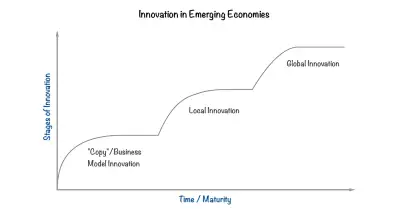
Source: Jerm/Techcentral
(I couldn’t resist posting this as an addendum to last Friday’s post.)
THREE STOOGES OF INNOVATION
We often hear that the future is here but not evenly distributed, but that begs the question: *how* does ‘the future’ get distributed?
The conventional view, fueled in part by Peter Thiel’s contrarian holy book, Zero to One is that there are two flavors: ‘0 to 1’, where you create something entirely new, and ‘1 to n’, where you take what already exists and modify/improve on it. The implication being that developed nations like the USA do actual innovation and everyone else adapts it for their markets.
In many ways, this seems intuitive. For example, time was, when ‘African tech’ had ‘social networks’ that existed only because Facebook did, or e-commerce sites that were cloned from the Amazon primitive. Obviously, consumers in the West go on websites with products arranged by category and add them to something called a ‘cart’, after which they ‘checkout’ with their cards, so is how ‘Africans’ must buy and sell henceforth. Obviously. Even today, we still describe our companies as [insert US startup] but for ‘Africa’.
But I think this view is incomplete.
In his book ‘The End of Copycat China’, Shaun Rein posited an interesting framework for thinking about how innovation spreads that I think brings us a little closer to the truth. Here:

Source: ‘The Spread of Innovation’ by Tanay Jaipuria
In stage 1, companies take things that already worked in developed markets, clone them, and adapt them to local markets. This is low-hanging fruit, and a good example is cash payments on delivery for e-commerce. The product roadmap for technology startups in this stage is clear (because someone else already drew it) and most of the ‘innovation’ is in the business model.
Stage 2 is when technology is developed to solve problems that only exist locally or only in similar markets. An example is Safaricom’s M-Pesa.
Stage 3 is “technological innovation at a global scale”. An example from China as seen this post is stationless bike-sharing, or “micro-mobility” which is the sector du jour in Silicon Valley.
It seems obvious that most of the companies in the African tech ecosystem are in stage 1, with some making their way to stage 2. This is not a bad thing. It’s a necessary part of the process, and I don’t think it applies only to tech innovation. (After all, time was, when Nigerian music was mostly P-Squaredoing their best Usher impressions. But now, ‘Nigerian music’ has an identity and is being exported to the world.)
But why does this matter? Well, here’s Techpoint:
TaxiTV, a Lagos based advertising-technology startup has secured an undisclosed amount of seed funding in a round led by Beta.Ventures. [...]
The startup provides advertising channels for corporate brands and SMEs through screens inside Taxify, Uber, and other ride-hailing services.
These advertorial video contents [sic] are displayed to passengers during a ride.
Screens in transport vehicles are not a new idea. Multiple companies have attempted to build similar products, but this one is of interest because of how it started. From a Medium post by the co-founders:
Back in October, when we, Co-founder Akinbola Asalu and Dami Osiyalecame up with the concept for TaxiTV, we envisioned that it was a crazy and unimaginable concept.
We had seen those screens in yellow cabs in New York, and we imagined it was a concept we could recreate in Lagos and in Nigeria in general.
Since then, TaxiTV has gone on to install their tablets in over 100 cars in Lagos, and now raised an “undisclosed” amount of seed funding (Pulse.ng reports$50,000) to scale. They plan to make money by serving a content sandwich: entertaining content for free, interspersed with ads paid for by local businesses. But to what end?
On both sides: content and advertising, TaxiTV suffers from the same ills that plague Multichoice, but without the pull of live sports or the operational muscle.
- Content: Uber’s 300,000 active Nigerian riders must own a smartphone to access the service, meaning they must...own a smartphone. Those smartphones have content on them (music, movies, Facebook, Twitter, Instagram comedians, WhatsApp, Snapchat, Apple Music, etc.) that consumers already want to consume. Because they know nothing about individual users who enter individual taxis, they can’t target content, and so their offering is not very valuable for most consumers.
- Advertising: In the exact same way, because they know next to nothing about customers (asides from geolocation and the same demographic profile every media company claims: female, mid-to-high income, 15 - 40, etc.), they can’t target their ads. TaxiTV may sell successfully to SMEs with experimental ad budgets, but at a larger scale where ad spend has to be justified, there is no reason to believe they compete favorably with Facebook and Google. Advertisers pay money for the ability to predict purchases, not “impressions”.
Here’s why this is important. Copying proven businesses from more developed markets is fine and dandy, but we need to add one more dimension to our analyses: direction. TaxiTV adapted a business idea on its way down, not one on its way up -- like being disrupted, but without any of the addictive profits.
Because most people are still offline, there may be a bull case for the company in shifting focus to that market in the short term. But the rest of the tech ecosystem is dependent on those same people coming online faster. Depending on how optimistic you are about internet penetration, consumer spending power, etc., TaxiTV is either many years too late, or right on time.
Place your bets now. Needless to say, I predict a pivot.
--
That’s all for today. Please share this edition if you liked it. Thank you for reading!
With love in my heart and adequately-microwaved rice in my belly,
Osarumen.
